35 Latest Content Marketing Statistics For 2024: The Definitive List

What is the state of content marketing?
The content marketing landscape is constantly changing. If you want to continue to generate the best results from your content marketing efforts, you need to change with it.
In this post, you’ll find 35 of the latest content marketing statistics, trends, and facts to inform your strategy.
These statistics provide useful insights into where the content marketing industry is and where it’s heading.
The stats below will also help to shed some light on important questions like:
- What are the best/most popular content distribution channels?
- How do you generate the best returns from your content marketing efforts?
- What kind of content performs best, video or blog posts?
- How much should brands spend on content marketing?
Editor’s top picks – content marketing statistics
These are our most interesting statistics about content marketing:
- 82% of companies report using content marketing. (Source: HubSpot State of Marketing Report 2021)
- Content marketing costs 62% less than traditional marketing. (Source: DemandMetric)
- Long-form blog content gets twice as many page views. (Source: Semrush)
Key content marketing statistics
First, let’s look at some of the most important content marketing statistics. These stats tell us more about the organizations using content marketing and the ways they’re using it.
1. 82% of companies report using content marketing
In 2020, only 70% of companies reported the same. This 12% increase shows that content marketing is anything but dead – it’s very much alive and kicking. More companies are adopting content marketing than ever before. If you haven’t already joined them, now may be the time to start.
However, the same report also found that 44% of those who don’t use content marketing yet aren’t sure if they’ll start this year. (Source: HubSpot State of Marketing Report 2021)
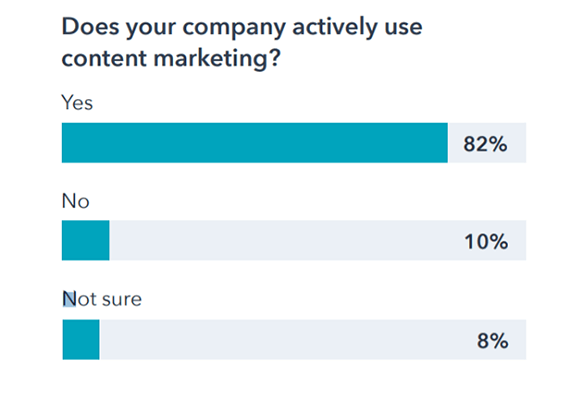
2. The average person spends around 7 hours consuming content daily
I know what you’re thinking – that’s a lot of screen time. But it’s true, global online content consumption more than doubled in 2020 as consumers were stuck indoors. The previous average was just a little over 3 hours.
This new figure shows just how much of a growing demand there is for content. It’s no surprise that so many businesses are focusing on creating content to meet this demand. (Source: Forbes)
3. 79% of content marketers use content marketing to generate high-quality leads
According to a recent report, generating high-quality leads is the number one priority goal of content marketing. Other popular goals amongst content marketers include driving traffic to their company website (75%) and improving their brand reputation (57%). (Source: SEMrush State of Content Marketing 2020 Global Report)

4. 51% of content marketers rate the performance of their strategy as ‘good’
This suggests overall, marketers are seeing a lot of success from their content marketing efforts. However, although the majority rate their performance as good, only 11% rate it as excellent. This suggests that there may still be a lot of room for improvement. (Source: SEMrush State of Content Marketing 2020 Global Report)

5. 75% of marketers say SEO is their most efficient content marketing tactic
No surprises here then. Content marketing has always been closely tied to SEO, as written content forms the backbone of most SEO campaigns.
If you didn’t already know, SEO stands for Search Engine Optimization. It involves optimizing your written content for search engines like Google or video hosting platforms like YouTube so that it’s more visible to your target audience. This can help you to generate more organic search traffic for your target keywords. (Source: SEMrush State of Content Marketing 2020 Global Report)
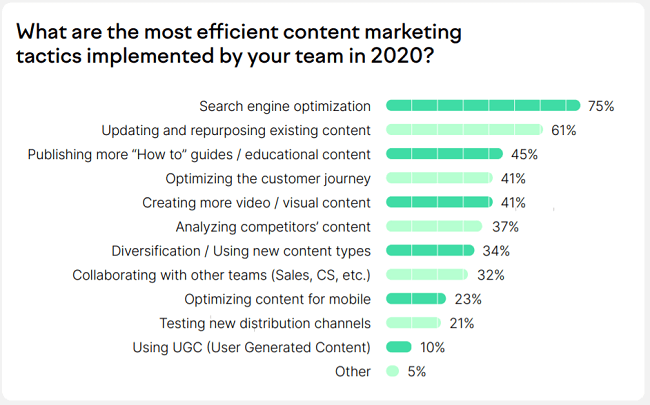
6. …And 61% said updating/repurposing existing content was the most efficient tactic
As this statistic shows, content marketing isn’t just about pumping out as much new content as possible. There’s a lot to be gained by periodically reviewing your existing content and updating it. Updating your content to make sure it’s still relevant can give it an SEO boost and help it to jump to the top of the SERPs.
You can also repurpose your content for different channels. For example, you could turn a blog post into a YouTube video, or extract quotes and use them in your social media campaigns. (Source: SEMrush)
7. Organic search is the most popular channel for content distribution
89% of companies distribute their content via organic search. Distributing content via organic search is as simple as making sure it’s indexed and optimizing it to give it the best chance of ranking.
You can also try to boost its organic search performance by promoting and building high-quality backlinks to your content. Social media is another top distribution channel, following closely behind organic search at 87%. (Source: SEMrush)
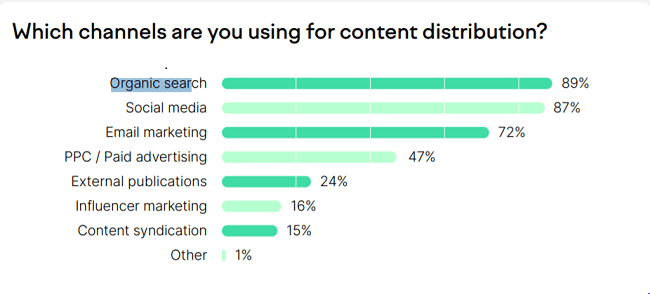
Content marketing costs and ROI
How much of your marketing budget should you be allocating to content marketing? And what kinds of returns can you expect to see on your investment? Let’s find out.
8. Content marketing costs 62% less than traditional marketing…
With content marketing, the biggest costs usually come from the production process. For example, you may have to pay writers to create compelling blog posts for your company blog.
However, unlike other forms of marketing, you don’t necessarily have to pay to distribute it. This makes it more affordable than other forms of traditional marketing like paid ads. (Source: DemandMetric)
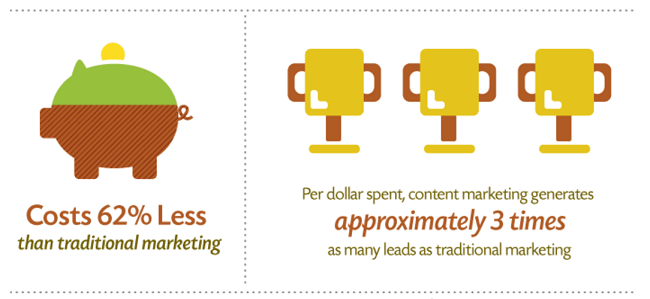
9. … And generates 3x as many leads
Despite being significantly more affordable than other marketing methods, content marketing still produces 3 times as many leads. Getting more leads into your funnel can lead to more sales and greater revenue. This is why content is still king. When it comes to return on investment, it’s unmatched. (Source: DemandMetric)
10. On average, companies allocate 26% of their marketing budget to content creation
Not sure how much you should be spending on content marketing? This might be a good benchmark to aim for. The average organization spends around a quarter of its total budget on content creation. You might also want to put some cash aside for other costs, like promoting and distributing your content. (Source: HubSpot State of Marketing Report 2021)

11. 37% of companies spend less than $10,000 on content marketing
SEMrush surveyed over a thousand marketers and asked them how much their companies spend on content marketing. Over a third said they spend less than $10,000, making this the most common spending bracket. A further 19% spent somewhere between $10,001 and $25,000. (Source: SEMrush)

12. … And only 4% spend $500,000+
While there were a fair number of companies that spent between $25,000 and $500,000, only 4% spent above that figure. 2% spent between 500k and 1M, 1% spent between 1M and 5M, and 1% spent more than 5M.
This is likely a reflection of the size of the companies that participated in the survey. Only very large enterprises have large enough revenue figures to warrant these kinds of marketing budgets. (Source: SEMrush)
13. 15% of marketers don’t know how much their company spends on content marketing
Interestingly, 15% of survey respondents said they didn’t know how much they were spending on content marketing. This may suggest that companies are finding it hard to keep track of their content marketing costs. (Source: SEMrush)
14. Most marketers measure the success of their content marketing efforts based on sales
Measuring returns on investment is always tricky, particularly when it comes to content marketing. Some returns are intangible and difficult to put a monetary figure on (like brand awareness and sentiment).
However, over 60% of marketers look at their sales figures to determine the success of their content marketing efforts. Other popular metrics used to gauge performance include web traffic, social engagement, and lead generation. (Source: HubSpot State of Marketing Report 2021)
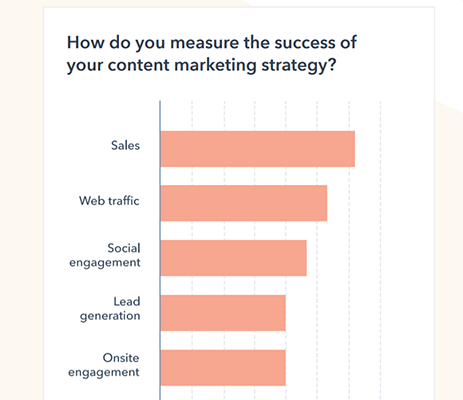
15. 30% of companies outsource their content creation efforts
Interestingly, a third of companies choose to outsource content creation rather than take care of it in-house. While outsourcing can sometimes raise the cost of content creation, it can also sometimes be a cost-efficient solution.
Outsourcing means you don’t have to spend time onboarding and training content marketers and can take advantage of a third-party’s expertise. (Source: SEMrush)
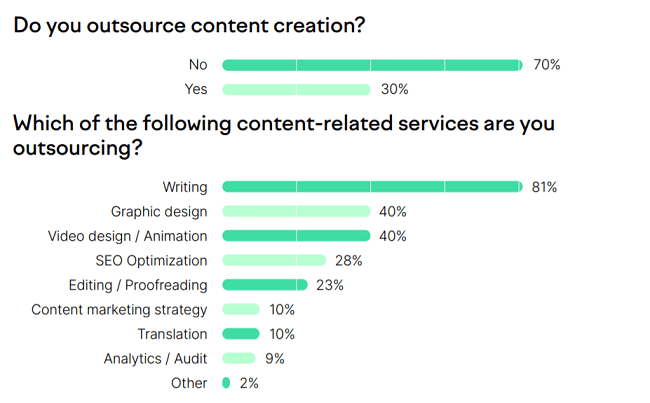
Blog content marketing statistics
For many marketers, ‘content’ means blog posts. Written content forms the backbone of most SEM/SEO campaigns, and blogs have long been one of the most popular content mediums. Here are some useful blog content marketing statistics to help guide your efforts.
16. 92% of marketers produce blog posts
If you don’t have a blog page on your company website, you’re in the minority. The vast majority of businesses regularly publish blog posts as part of their content marketing efforts. Blog posts can be a great way to generate inbound traffic, nurture leads, and educate your existing customers about your products or services. (Source: SEMrush)
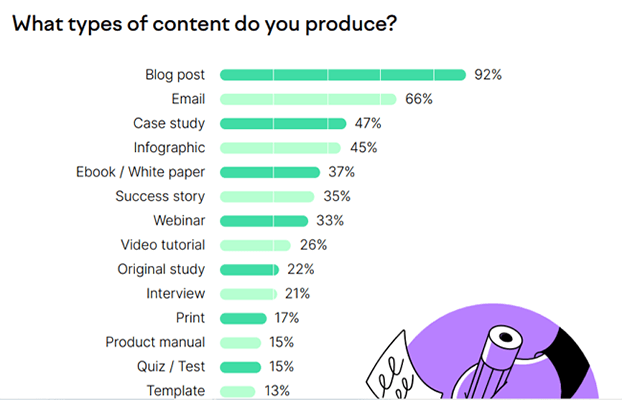
17. Companies with blogs produce 67% more leads per month
It’s unsurprising so many companies publish blog posts given that those that do generate 67% more leads every month. If you’re still undecided about whether or not it’s worth investing in content marketing, ask yourself how much 67% more leads would be worth to your business? (Source: DemandMetric)

18. Long-form blog content gets twice as many page views
By long-form, we’re talking about content that is 3,000+ words long. This kind of content dramatically outperforms shorter content when it comes to page views. It also generates 24% more shares.
So why is long-form content so effective? Well, for one, it’s more likely to rank better in the search engines results pages for your target keyword. Google’s ranking algorithm seems to prefer long-form content that covers a topic in-depth, which means longer blogs tend to land the top spots. This translates to more organic traffic. (Source: SEMrush)
19. Posts containing frequent lists generate 70% more traffic
If you’re writing long-form blog posts, don’t make the mistake of just writing a huge wall of continuous prose. Break up those long sections with bulleted or numbered lists. This aids with readability and may even improve SEO.
In fact, blog posts that include at least one list per 500 words of text generate 70% more traffic than those that don’t, on average. (Source: SEMrush)
20. Blog posts with images perform significantly better than those without
According to the data, blog posts that include images generate 2-4x more traffic, 30% more shares, and 25% more backlinks.
The effects seem to be greater the more images you include blog posts that include one image get twice the traffic, whereas those with 7+ images increase traffic fourfold.
The takeaway: include screenshots, images, and infographics within your written content. Not only do images make blog posts more digestible and captivating for the reader, but they also lead to better results. (Source: SEMrush State of Content Marketing 2020 Global Report)
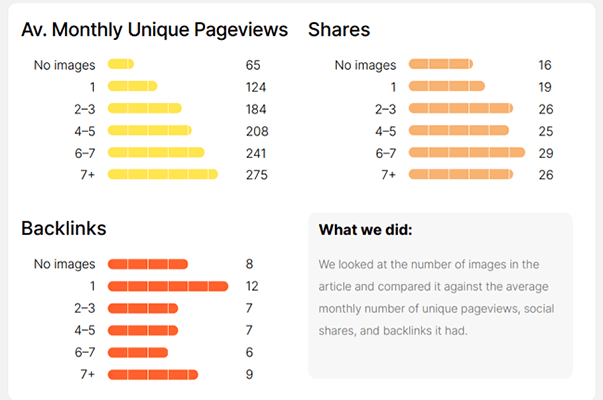
21. List headlines generate the most pageviews
Interestingly, the type of headline you use on your blog post seems to have a big impact on its performance. According to a report by SEMrush, blog posts with list headlines (like the one you’re reading right now) generate an average of 247 unique pageviews. That’s more than any other headline type.
How-to headlines are the second-best performing in terms of page views, generating 206 on average. List-style posts also generate the most backlinks, on average, and the second-most social shares. (Source: SEMrush State of Content Marketing 2020 Global Report)
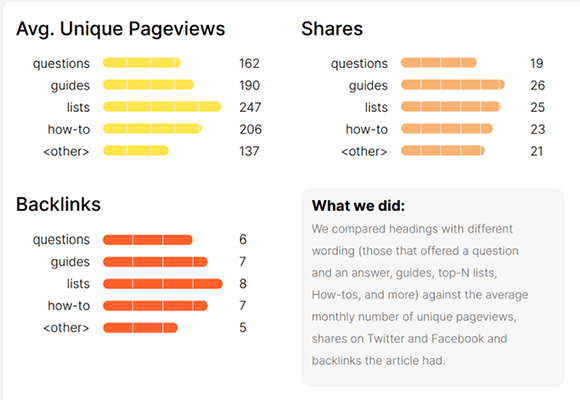
22. 39% of blog posts with no structure are low-performing
By structure, we’re talking about heading tags (H2, H3, H4, etc.). The report found that 39% of blog posts that lacked any heading tags whatsoever were low-performing. On the other hand, more than half of those with a complex structure (H2s, H3s, H4s, etc.) were found to be high-performing.
The takeaway: use headings to break up your content. A good rule of thumb is to break up your content with subheadings at least once every 300 words. (Source: SEMrush State of Content Marketing 2020 Global Report)
Video content marketing statistics
In 2021, video content is more popular than ever. The statistics below tell us more about this increasingly important content medium and how brands are leveraging video in their strategies.
23. Video is the most common form of media used in content strategies
If you thought blog posts were the most popular form of content, think again. Video has actually taken the top spot for the last two years in a row. It’s now the primary form of media for over 60% of companies.
Blogs were the second most popular, used by over 50% of marketers. Infographics took the third spot and were used over 40% of the time. (Source: HubSpot State of Marketing Report 2021)
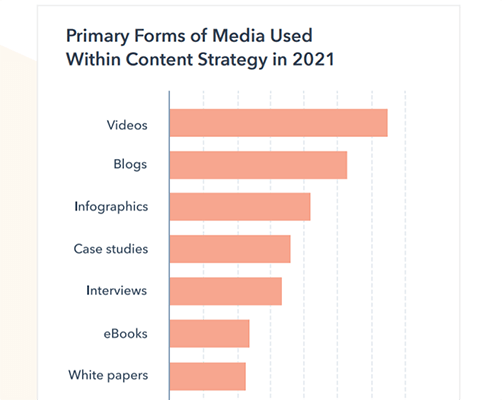
24. The average number of video minutes watched increased by 85% in 2020
In total, consumers watched 12.2 billion minutes worth of video content last year. To put that into perspective, that’s more than 23,000 year’s worth of content. Crazy, right?
So, why the sudden increase in watch time? Well, it’s almost certainly due to the pandemic. Offices closed and consumers all across the world were forced to stay at home due to national lockdowns. This means they had much more time to spend on their devices consuming entertaining content. (Source: HubSpot State of Marketing Report 2021)
Related Reading: 60 Video Marketing Statistics And Trends You Should Know.
25. The number of long-form videos created grew by 140% last year
Long-form videos are becoming more and more popular with web users. According to the HubSpot State of marketing report 2021, the number of videos that were 30-60 minutes in length grew by around 140% in 2020.
For content marketers, this is great news, as it shows that consumers are more engaged in video content than ever, and businesses can take advantage of this. Longer video content options mean more opportunities to nurture leads, provide useful information, and convert viewers into customers. (Source: HubSpot State of Marketing Report 2021)
26. YouTube is the most popular channel for viewing video content online…
It’s no surprise that YouTube is still the front-runner when it comes to video content. It was the original video viewing platform and it continues to grow in popularity year on year.
In a HubSpot survey, 83% of respondents overall said that they mainly watched videos on YouTube. The platform has around 122 million daily active users and there’s no doubt that YouTube is an extremely useful platform for content marketers looking to make the most of video content within their strategies. (Source: HubSpot Content Trends)

27. … But Facebook is catching up
Facebook is also a favorite platform amongst video lovers and is quickly catching up to YouTube as the go-to place for video content. In the same HubSpot survey, 67% of respondents reported that they currently watch videos on Facebook.
Facebook is also extremely popular with advertisers as it has a great ad structure that businesses can utilize. Therefore it offers a great opportunity for content marketers looking to run video ads. (Source: HubSpot Content Trends)
28. 41% of marketers said creating visual/video content was the most efficient content marketing strategy
Video content is extremely popular amongst consumers, and some marketers even go as far as to say that increasing video content creation and output is the most efficient content marketing strategy. Just under half of the marketers believe this to be the case.
However, as video content continues to grow in popularity, it’s likely that it will grow in popularity as a marketing strategy too. (Source: SEMrush State of Content Marketing 2020 Global Report)
Content marketing trends
Finally, let’s take a look at some of the latest trends in the content marketing landscape.
29. 42% of marketers use content automation
Content automation can be an extremely useful tool for marketers. Content marketing involves a lot of repetitive tasks that can take up a big chunk of time.
This time is often better spent on content ideation and creation. As such, many marketers are turning to tools like IFTTT to streamline their processes and save time.
As of 2021, less than half of content marketers take advantage of content automation, however as more tools are being developed, it’s likely that content automation adoption will continue to grow in the coming years. (Source: HubSpot State of Marketing Report 2021)
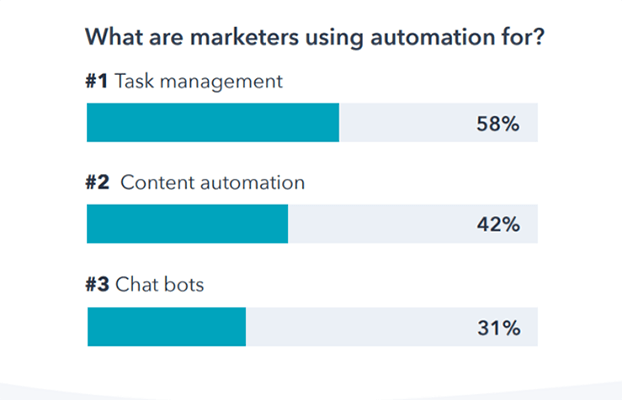
30. 88% of content marketing teams use web analytics tools
Web analytics tools like Google Analytics and SEMrush and more are invaluable to content marketers. Without them, they wouldn’t be able to plan and create content that converts, and they’d also struggle to track results for the clients and businesses that they work with.
In most cases, content marketing teams may use a selection of web analytics tools to develop detailed strategies for lead generation, sales, and building brand awareness. With that in mind, it’s no surprise that 88% of content marketing teams utilize these tools. (Source: SEMrush State of Content Marketing 2020 Global Report)

31. 82% of content marketing teams also use SEO tools
SEO tools are also extremely important for helping content marketers achieve their goals. Content marketing strategies like blogging rely heavily on SEO insights and knowledge in order to succeed therefore it’s imperative for teams to have a useful tool like SE Ranking or Moz to inform their decisions. Although SEO tools are slightly less popular than web analytics tools, over 80% of all content marketing reams still utilize them. (Source: SEMrush State of Content Marketing 2020 Global Report)
32. 73% of the top marketers use content to nurture their audience
When it comes to content marketing, many view it as a way to boost brand awareness. However, content can be used in a multitude of ways at different points in the sales funnel.
According to a study by Content Marketing Institute, 73% of top performers within the content marketing industry use content to nurture leads, audiences, and subscribers. Amongst less successful content marketers, only 38% use content in this way. (Source: Content Marketing Institute)
33. 94% of marketers changed their content marketing strategy in response to the pandemic…
The COVID-19 pandemic prompted many changes in all industries, and content marketing was also affected. According to Content Marketing Institute, over 90% of businesses made changes to their content strategy in response to the crisis. Reportedly, 70% of marketers adjusted their messaging strategy, and 64% made changes to their editorial calendars. (Source: Content Marketing Institute)
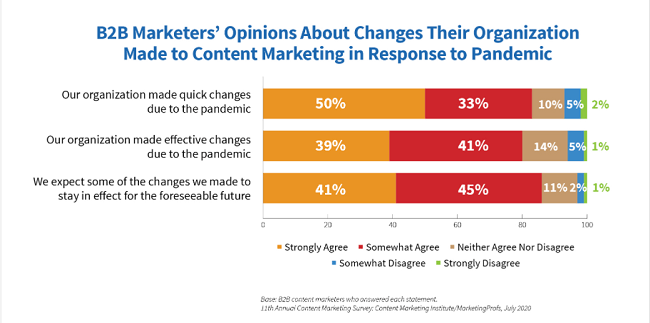
34. …And 80% say those changes were effective
Although adapting to the challenges presented by the pandemic was difficult for some marketers, 80% reported that the changes they made were effective and helped them stay on the top of their game during the unprecedented events of 2020. (Source: Content Marketing Institute)
35. 68% of marketers expect their content marketing budget to increase this year
As you can see from the statistics in this article, content marketing is an extremely effective strategy for achieving a range of goals including lead generation, building brand awareness, driving web traffic.
As its popularity grows, more and more companies are recognizing the benefits of a good content marketing strategy. As such, more than 50% of marketers expect their content marketing budget to continue rising in the year ahead. (Source: SEMrush State of Content Marketing 2020 Global Report)
How successful is content marketing?
Content marketing is still considered to be one of the most effective marketing strategies in 2021. Many businesses continue to run successful content marketing campaigns that generate results, for example:
- 49% of survey respondents successfully used content marketing to generate sales last year (Enterprise Content Marketing 2020)
- 79% of companies have successfully used content marketing to generate better leads (SEMrush)
- Companies that used content marketing achieved 27.1% higher win rates than those that didn’t (CSO Insights)
What content marketing ‘success’ looks like will depend on your goals. For some companies, ‘success’ might mean increasing organic traffic by 50% in 6 months. For others, ‘success’ might mean driving brand awareness or boosting sales.
Whatever your goals are, content marketing can help you to get there.
How much does content marketing increase sales?
Content marketing can substantially increase sales. It’s tough to put a figure on exactly how much you can increase your sales by, as it depends on many different factors.
However, one study found that focusing on content marketing increases website conversion rates by more than 5x, on average. That’s potentially 5x more sales.
Content marketing can also indirectly support your sales goals by helping you to generate more inbound leads, nurture your existing leads, and improve brand awareness.
Is content marketing dead?
Content marketing isn’t dead. On the contrary, more businesses are spending more of their marketing budgets on content marketing every year.
However, while content marketing isn’t dead, it is changing. If you want to keep seeing success from your content marketing efforts, it’s important to keep your finger on the pulse and adapt to changing consumer habits and content marketing trends.
Content marketing statistics sources:
Conclusion
As you can see, content marketing is an interesting and ever-changing industry. When utilized correctly it can be an invaluable way to generate leads and increase sales for your business.
Hopefully, this roundup of the latest content marketing statistics helped you to develop a better understanding of content marketing, and the trends to look out for going forward.
All of the statistics above can help you make informed decisions about your own content marketing strategy.
Looking for more statistics? Have a read of these:

